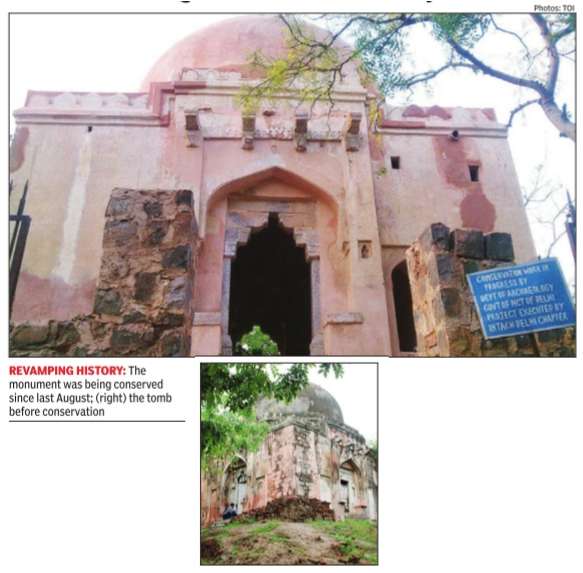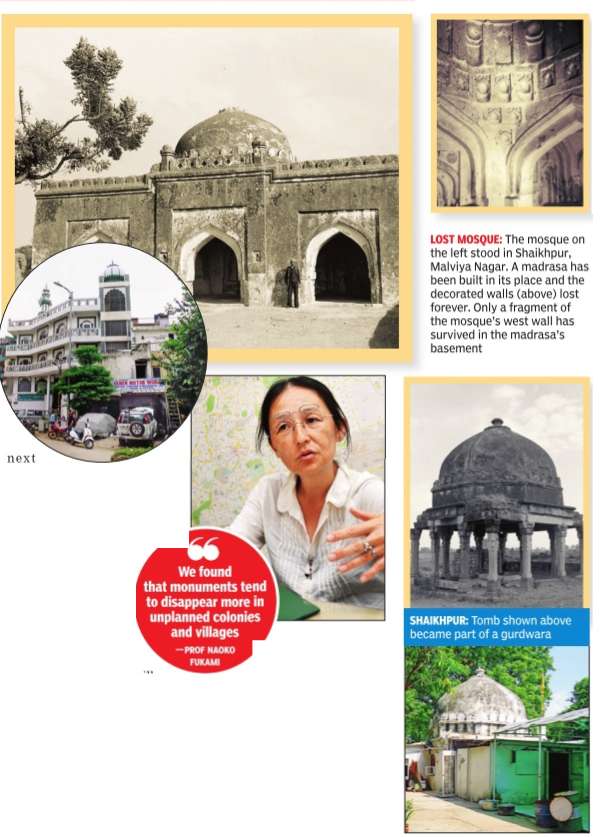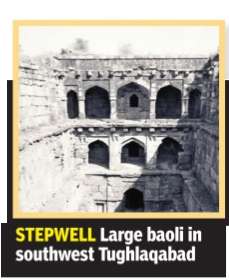Delhi: Monuments (general issues)
| Line 51: | Line 51: | ||
“The tomb has been put to various uses in the past. It is located in a modern locality of Delhi, inside the DDA park and is prominently visible from the main road. Now that, the tomb is secured by the government, it will be conserved and restored appropriately by rectifying all wrong repair works done and by recreating lost features. The surrounding must also be developed after procuring land from the DDA.Once conserved and developed, the residents are definitely going to appreciate this unique historic structure in their locality and take pride in it,'' said an official. | “The tomb has been put to various uses in the past. It is located in a modern locality of Delhi, inside the DDA park and is prominently visible from the main road. Now that, the tomb is secured by the government, it will be conserved and restored appropriately by rectifying all wrong repair works done and by recreating lost features. The surrounding must also be developed after procuring land from the DDA.Once conserved and developed, the residents are definitely going to appreciate this unique historic structure in their locality and take pride in it,'' said an official. | ||
| + | |||
| + | |||
| + | =Missing monuments= | ||
| + | [http://epaperbeta.timesofindia.com/Article.aspx?eid=31808&articlexml=Heres-proof-of-citys-monumental-loss-21082015008005 ''The Times of India''], Aug 21 2015 | ||
| + | [[File: Tomb of Sheikh Saladaddin.jpg| Tomb of Sheikh Saladaddin; Graphic courtesy: [http://epaperbeta.timesofindia.com/Article.aspx?eid=31808&articlexml=Heres-proof-of-citys-monumental-loss-21082015008005 ''The Times of India''], Aug 21 2015|frame|500px]] | ||
| + | [[File: Mosque, Shaikhpur.jpg| Graphic courtesy: [http://epaperbeta.timesofindia.com/Article.aspx?eid=31808&articlexml=Heres-proof-of-citys-monumental-loss-21082015008005 ''The Times of India''], Aug 21 2015|frame|500px]] | ||
| + | [[File: Queen's reservoir.jpg|Graphic courtesy: [http://epaperbeta.timesofindia.com/Article.aspx?eid=31808&articlexml=Heres-proof-of-citys-monumental-loss-21082015008005 ''The Times of India''], Aug 21 2015|frame|500px]] | ||
| + | [[File: Stepwell, Delhi.jpg| Graphic courtesy: [http://epaperbeta.timesofindia.com/Article.aspx?eid=31808&articlexml=Heres-proof-of-citys-monumental-loss-21082015008005 ''The Times of India''], Aug 21 2015|frame|500px]] | ||
| + | [[File: Hamam, Delhi.jpg| Graphic courtesy: [http://epaperbeta.timesofindia.com/Article.aspx?eid=31808&articlexml=Heres-proof-of-citys-monumental-loss-21082015008005 ''The Times of India''], Aug 21 2015|frame|500px]] | ||
| + | [[File: Tomb of Sheikh Usman.jpg| Tomb of Sheikh Usman; Graphic courtesy: [http://epaperbeta.timesofindia.com/Article.aspx?eid=31808&articlexml=Heres-proof-of-citys-monumental-loss-21082015008005 ''The Times of India''], Aug 21 2015|frame|500px]] | ||
| + | [[File: Idgah Gumbad, Delhi.jpg|Idgah Gumbad, Delhi; ; Graphic courtesy: [http://epaperbeta.timesofindia.com/Article.aspx?eid=31808&articlexml=Heres-proof-of-citys-monumental-loss-21082015008005 ''The Times of India''], Aug 21 2015|frame|500px]] | ||
| + | |||
| + | |||
| + | Richi Verma | ||
| + | |||
| + | ''' City's monumental loss ''' | ||
| + | |||
| + | Japanese team retraces steps of archaeological experts who visited Delhi in 1960 and finds many of the monuments they saw missing | ||
| + | Until the 1960s, there was a large baoli with four lev els in southwest Tugh laqabad that--although not lined with as many arches as Agrasen ki Baoli near Connaught Place--would have counted among the city's finer mediaeval stepwells.An expanding village swallowed it whole at some point in time. | ||
| + | The baoli would have been completely forgotten but for the documents and plate camera images left behind by a Japanese team that surveyed more than 400 monuments over six months during 1959-60. Fifty five years later, another Japanese team is revisiting those monuments to document the changes they have undergone. So far, their findings have been disappointing. In less than 10 days, the five experts have traced about 80 of the loca tions but found that many of the striking mosques and tombs that stood there have disappeared, while many others are barely recognizable today . | ||
| + | |||
| + | “Our aim is to com pare how the monuments and the urban setting around them have changed,“ said Prof Naoko Fukami, director of the Japan Society for Promotion of Science research station in Cairo, who is leading the team as part of a research project. | ||
| + | |||
| + | The 1960 survey team had selected 400 monuments from a list compiled by Maulvi Zafar Hasan in the early-1900s. “Now we want to see how these 400 monuments have evolved since then,'' she said. | ||
| + | |||
| + | The Japanese team is working with the Delhi chapter of heritage conservation body Intach, which is helping them get permissions from ASI, the state archaeology department and other agencies for visits. It has covered Chirag Dilli, Tughlaqabad, Siri Fort, Hauz Khas and Malviya Nagar and will survey Mehrauli, Nizamuddin, central Delhi and Old Delhi before the project concludes next y e a r.The 1960 team included three historians and a senior professor. | ||
| + | |||
| + | “We found that monuments tend to disappear more in unplanned colonies and villages,“ said Fukami. villages,“ said Fukami.“In Chirag Dilli, a new mosque has come up in place of a Lodhi-era mosque. Only portions of the old wall are visible. Many other monuments have been altered and defaced.'' The team's research will be compiled in three volumes and serve as reference material for future projects. | ||
| + | |||
| + | Intach officials said the project shows how Delhi's heritage is disap pearing rapidly . “So far we've had the Zafar Hasan list of 1912 which is not very well detailed, and then we came out with the Intach Built Heritage listing in 2000. This survey from 1960 shows how the monu ments have evolved through the decades and is a new reference point for us,'' said Intach convener Prof AGK Menon. | ||
| + | |||
| + | Intach's director (project) Ajay Kumar said, “Currently, we are working on unprotected monuments and the survey provides new resource material for us. The findings are a matter of concern and need to be addressed.'' | ||
Revision as of 09:01, 22 August 2015

For individual monuments please click Places at the bottom of this page and look up under the concerned letter e.g. 'Delhi: J' Or enter the name of the monument in the Search box.
Eight types of monuments
Eight types of monuments in Delhi: NMA
FOR FRAMING BYLAWS
The Times of India New Delhi: TIMES NEWS NETWORK Jul 30 2014
Over four years after the new and amended ASI Act was enforced, the process of framing heritage bylaws for Delhi’s protected monuments is taking longer than ever. Only bylaws for Sher Shah Gate and Khair-ul Manzil have been notified, with the process for final notification of Begumpuri Masjid’s bylaws still an ongoing one. Under pressure to speed up the process, National Monuments Authority is looking at eight categories of monuments to identify characteristics of each for framing of common bylaws.
A draft outlining the categories has been prepared to which NMA has invited objections and suggestions from the public. ASI is also being consulted for views. On the list, though, there are only 160 protected monuments existing in Delhi, with the remaining 14 either missing or denotified.
“The draft has been prepared in accordance with regulations of ASI Act. It will eventually be sent to the culture ministry for final phase notification,“ said a top NMA official. The categories are also expected to help in urban development projects in which clearances will be required for monument-controlled areas. The categorization was mostly done internally within NMA, though comments and suggestions were invited from experts from various fields like architecture, conservation, urban planning, etc. Once the categories are notified by the Centre, monuments under various categories will get the official tag. “It will also help in the protection of monuments and increasing tourist foot fall. Monuments that face threats of ur banization and encroachment have been listed separately so that a closer tab can be kept on them,“ said an official.
While Delhi has three world heritage sites--Qutub Minar, Humayun's Tomb and Red Fort, ' ' first category of protected monuments and archaeological sites inscribed S on Unesco's world heritage list also includes monuments like Arab ki Sarai, t Nila Gumbad, Hindu Iron Pillar and Tomb of Afsar-wala which fall in the vi i cinity of these sites.
Category II has ten monuments including Delhi Gate, Ajmeri Gate, Mutiny Telegraph Memorial, and Tomb of Razia Begum which are on a tentative Unesco heritage list.
The third category has ten buildings located in New Delhi area while the fourth category consists of ticketed monuments. Category V only mentions Najaf Khan Tomb as a monument with an adequate flow of visitors identified for charging fee. The sixth category consists of living monuments which receive a large number of visitors and pilgrims and buildings where worship and rituals are conducted.
The seventh category has monuments located in urban/semi-urban limits and remote villages. Sources said this category is critical. It’s further classified in three sub-categories on basis of intensity of urban pressure. While subcategory A has 18 monuments facing severe urban pressure with heavy construction activity in close vicinity, subcategory B has some monuments facing urban pressure but possessing significant greenery.
The final (eighth) category includes archaeological parks
Revival of abused Lodi-era monument
The Times of India, Jun 01 2015

Richi Verma
Abused Lodi-era tomb gets new life
For decades, this Lodi-era monument served as a library , a venue for community gatherings and a makeshift living area for squatters. However, this unknown tomb located in a public park in upscale Greater Kailash I area has just been revived. The monument, which had fallen victim to neglect, deteriorated with time, and saw rapid encroachment through the years, was hand-picked for an elaborate conservation and protection programme by the India National Trust for Art and Cultural Heritage (Intach) in a collaborative project with the Delhi government's archaeology department.
The project started last August, and since then, a considerable difference can be seen in the historic building. Though located inside a central park near Nblock market, the monument has rarely seen any visitors.
“It is on a raised mound and clearly visible from the main road. Towards its south, there are a series of steps made at a later date. In the immediate surrounding or in the park, there are no other historic monuments. However, the Lodi-period monuments in the Zamrudpur village are in the vicinity , said officials.
Through the decades, a num ber of alterations were made to its original facade. “Cement plaster was used extensively and even a room was constructed near the dome which was razed. It took a lot of time and effort to remove the alterations without harming the structure.We managed to get hold of archival pictures from the 1950s which showed us how the building used to look like originally. This helped us recreate missing elements as well, said Intach officials.
Portions of the mehrab were missing and the niches were buried under the cement plaster. The red and blue hand running through the interiors were hardly visible and had to undergo chemical cleaning. “The medallions were defaced and all decorative elements suffered immense damage and decay from years of neglect, said an official.
The tomb stands on a mound about a height of 3.5m from the ground level around. “There is no mention of any enclosure wall by Zafar Hasan; however, there are some remains of a stone wall to the east of the tomb, which seems like a retaining wall. Further investigation need to be done in this regard, reads a description of the monument in the Intach listing.
Architecturally , the tomb has a square plan and has some unique features such as the sand stone brackets supporting the chajja, rectangular openings stone pillars, lintels and brackets, domed ceiling with bands in incised plaster etc which attributes the tomb to belong to either Tughlaq or early Lodi period.
“The tomb has been put to various uses in the past. It is located in a modern locality of Delhi, inside the DDA park and is prominently visible from the main road. Now that, the tomb is secured by the government, it will be conserved and restored appropriately by rectifying all wrong repair works done and by recreating lost features. The surrounding must also be developed after procuring land from the DDA.Once conserved and developed, the residents are definitely going to appreciate this unique historic structure in their locality and take pride in it, said an official.
Missing monuments
The Times of India, Aug 21 2015







Richi Verma
City's monumental loss
Japanese team retraces steps of archaeological experts who visited Delhi in 1960 and finds many of the monuments they saw missing Until the 1960s, there was a large baoli with four lev els in southwest Tugh laqabad that--although not lined with as many arches as Agrasen ki Baoli near Connaught Place--would have counted among the city's finer mediaeval stepwells.An expanding village swallowed it whole at some point in time. The baoli would have been completely forgotten but for the documents and plate camera images left behind by a Japanese team that surveyed more than 400 monuments over six months during 1959-60. Fifty five years later, another Japanese team is revisiting those monuments to document the changes they have undergone. So far, their findings have been disappointing. In less than 10 days, the five experts have traced about 80 of the loca tions but found that many of the striking mosques and tombs that stood there have disappeared, while many others are barely recognizable today .
“Our aim is to com pare how the monuments and the urban setting around them have changed,“ said Prof Naoko Fukami, director of the Japan Society for Promotion of Science research station in Cairo, who is leading the team as part of a research project.
The 1960 survey team had selected 400 monuments from a list compiled by Maulvi Zafar Hasan in the early-1900s. “Now we want to see how these 400 monuments have evolved since then, she said.
The Japanese team is working with the Delhi chapter of heritage conservation body Intach, which is helping them get permissions from ASI, the state archaeology department and other agencies for visits. It has covered Chirag Dilli, Tughlaqabad, Siri Fort, Hauz Khas and Malviya Nagar and will survey Mehrauli, Nizamuddin, central Delhi and Old Delhi before the project concludes next y e a r.The 1960 team included three historians and a senior professor.
“We found that monuments tend to disappear more in unplanned colonies and villages,“ said Fukami. villages,“ said Fukami.“In Chirag Dilli, a new mosque has come up in place of a Lodhi-era mosque. Only portions of the old wall are visible. Many other monuments have been altered and defaced. The team's research will be compiled in three volumes and serve as reference material for future projects.
Intach officials said the project shows how Delhi's heritage is disap pearing rapidly . “So far we've had the Zafar Hasan list of 1912 which is not very well detailed, and then we came out with the Intach Built Heritage listing in 2000. This survey from 1960 shows how the monu ments have evolved through the decades and is a new reference point for us, said Intach convener Prof AGK Menon.
Intach's director (project) Ajay Kumar said, “Currently, we are working on unprotected monuments and the survey provides new resource material for us. The findings are a matter of concern and need to be addressed.